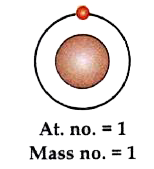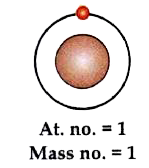Draw diagrams representing the atomic structures of the following:
Carbon atom
To draw the atomic structure of a carbon atom, follow these steps:
Step 1: Identify the Components of a Carbon Atom
A carbon atom has:
- Atomic Number: 6 (indicating it has 6 protons)
- Mass Number: 12 (indicating it has a total of 12 protons and neutrons combined)
- Electrons: 6 (since the number of electrons equals the number of protons in a neutral atom)
Step 2: Draw the Nucleus
1. Start by drawing a small circle in the center of your diagram to represent the nucleus.
2. Inside the nucleus, write "6p" to indicate the 6 protons and "6n" to indicate the 6 neutrons (since the mass number is 12, and the number of neutrons is mass number - atomic number).
Step 3: Draw the Electron Shells
1. Draw two concentric circles around the nucleus to represent the electron shells.
2. The first shell (K shell) can hold a maximum of 2 electrons. Draw two small dots on the first shell to represent these electrons.
3. The second shell (L shell) can hold a maximum of 8 electrons, but since carbon has only 4 electrons in this shell, draw four small dots on the second shell.
Step 4: Label the Diagram
1. Label the nucleus as "Nucleus" and indicate the protons and neutrons.
2. Label the first shell as "K shell" and the second shell as "L shell".
3. Optionally, you can label the electrons with a negative sign (-) to indicate their charge.
Final Diagram Representation
Your final diagram should look something like this:
Lshell−−−−−−−−−∙∙∙∙−−−−−−−−−Nuc≤us6p+6n−−−−−−−−−Kshell∙∙−−−−−−−−−
A carbon atom has:
- Atomic Number: 6 (indicating it has 6 protons)
- Mass Number: 12 (indicating it has a total of 12 protons and neutrons combined)
- Electrons: 6 (since the number of electrons equals the number of protons in a neutral atom)
1. Start by drawing a small circle in the center of your diagram to represent the nucleus.
2. Inside the nucleus, write "6p" to indicate the 6 protons and "6n" to indicate the 6 neutrons (since the mass number is 12, and the number of neutrons is mass number - atomic number).
1. Draw two concentric circles around the nucleus to represent the electron shells.
2. The first shell (K shell) can hold a maximum of 2 electrons. Draw two small dots on the first shell to represent these electrons.
3. The second shell (L shell) can hold a maximum of 8 electrons, but since carbon has only 4 electrons in this shell, draw four small dots on the second shell.
1. Label the nucleus as "Nucleus" and indicate the protons and neutrons.
2. Label the first shell as "K shell" and the second shell as "L shell".
3. Optionally, you can label the electrons with a negative sign (-) to indicate their charge.
Your final diagram should look something like this:
Topper's Solved these Questions
- ATOMIC STRUCTURE AND CHEMICAL BONDINGBOOK - ICSECHAPTER - ATOMIC STRUCTURE AND CHEMICAL BONDINGEXERCISE - EXERCISE 4(D)
21 Videos
- ATOMIC STRUCTURE AND CHEMICAL BONDINGBOOK - ICSECHAPTER - ATOMIC STRUCTURE AND CHEMICAL BONDINGEXERCISE - EXERCISE 4(B)
12 Videos
- ATMOSPHERIC POLLUTIONBOOK - ICSECHAPTER - ATMOSPHERIC POLLUTIONEXERCISE - EXERCISE 8(D)
38 Videos
- CHEMICAL CHANGES AND REACTIONSBOOK - ICSECHAPTER - CHEMICAL CHANGES AND REACTIONSEXERCISE - EXERCISE 2(C)
30 Videos
Similar Questions
Draw diagrams representing the atomic structures of the following:
Sodium atom
View SolutionDraw diagrams representing the atomic structures of the following:
Oxide ion.
View SolutionDraw diagrams representing the atomic structures of the following:
Chloride ion
View SolutionStructure of Atom
View SolutionStructure of Atom
View SolutionDraw a diagram of the internal structure of the human ovary.
View SolutionThe diagram represents an isotope of hydrogen (H). Answer the following:
Do isotopes have the same atomic number or the same mass number.

View SolutionThe diagram represents an isotope of hydrogen (H). Answer the following:
Are isotopes atoms of the same element or different elements.

View SolutionDraw a labelled diagram of the structure of the eye.
View SolutionWhich of the following has/have asymmetric carbon atom?
View Solution
